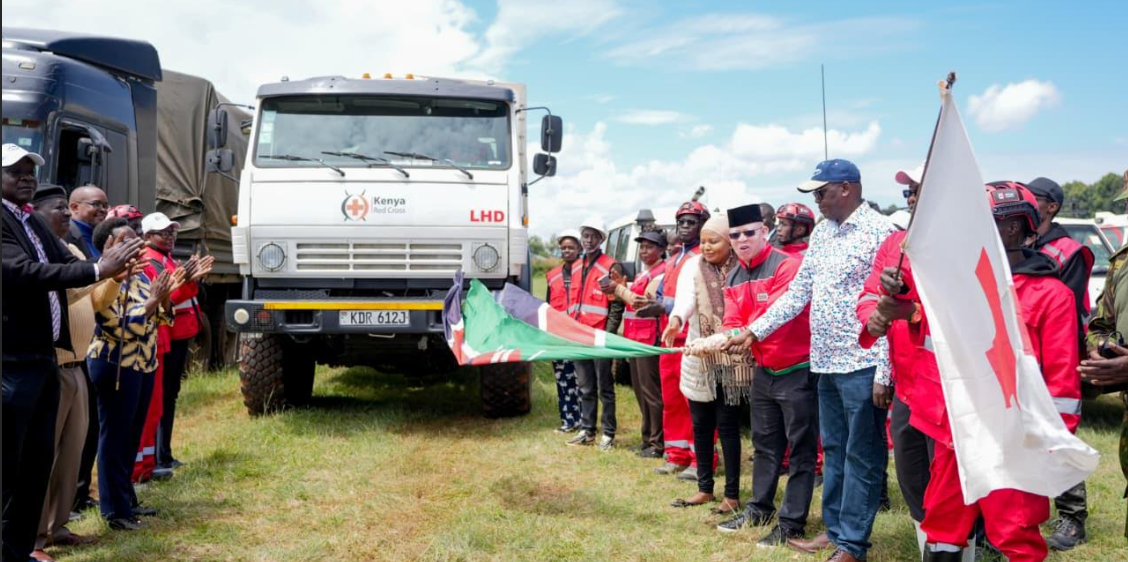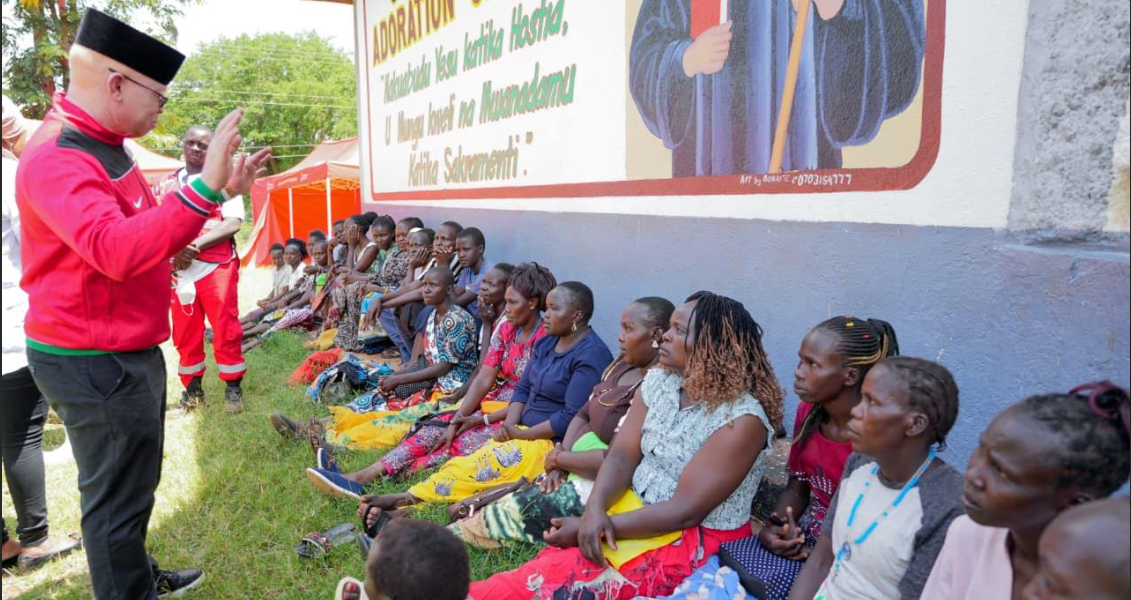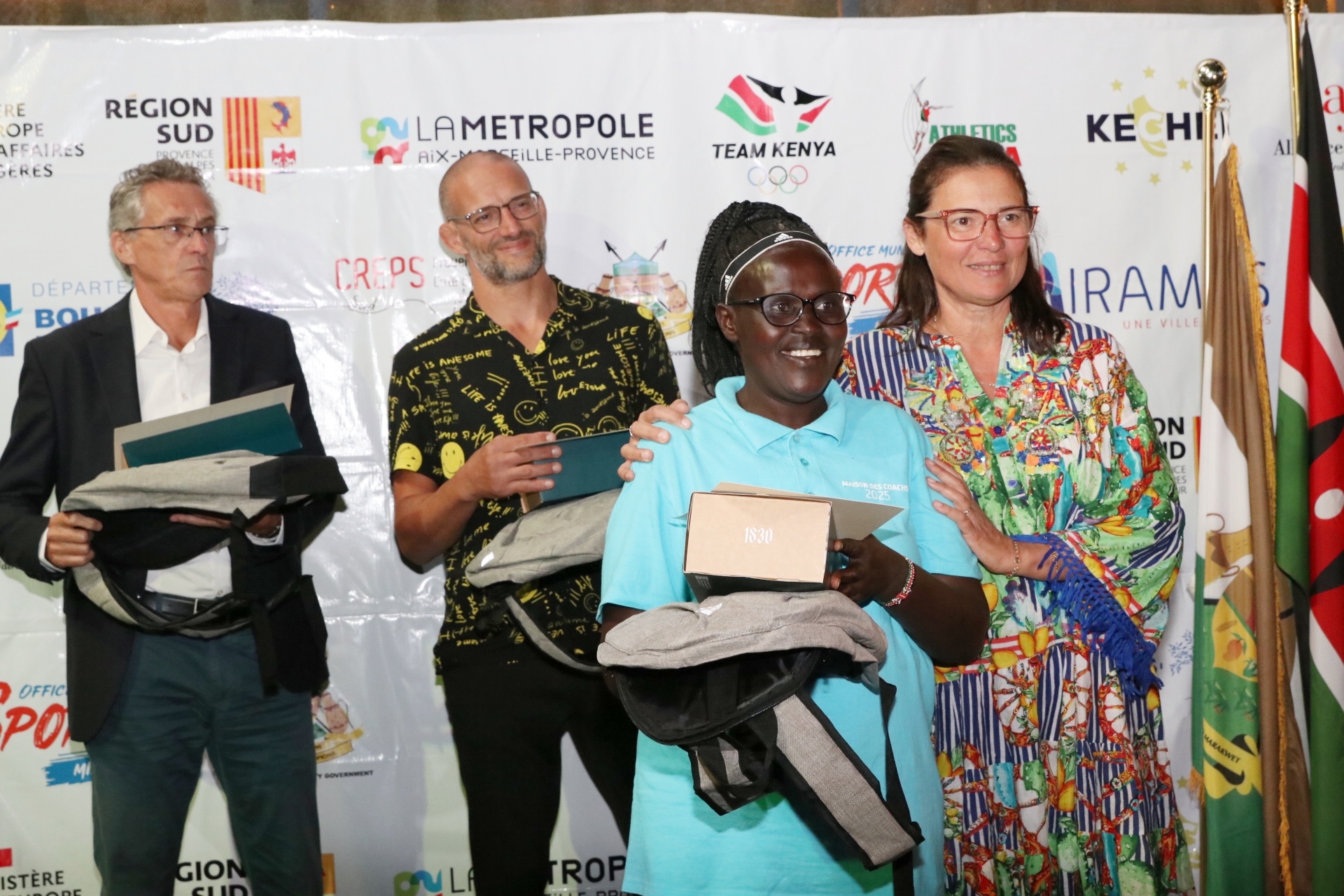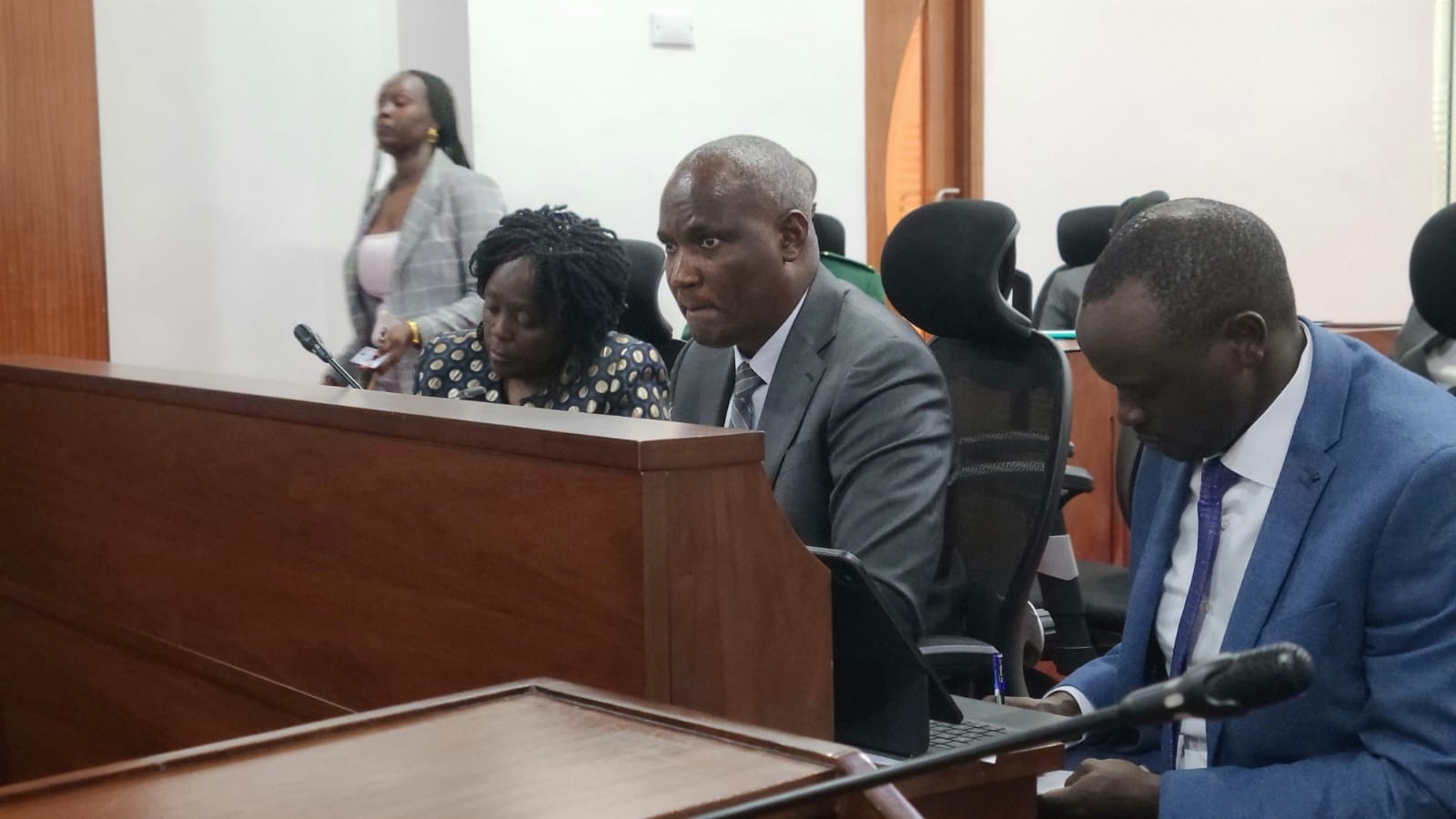
 Government Spokesperson Dr. Isaac Mwaura and his Deputy Ms. Mwanaisha Chidzuga
(Centre) lead other members of the Multi Agency team in charge of the search and rescue of
the mudslide incident, lead in receiving foodstuffs and non-food items at the Eldoret Airport. (Photos by Mathew Gwendo (OGS).
Government Spokesperson Dr. Isaac Mwaura and his Deputy Ms. Mwanaisha Chidzuga
(Centre) lead other members of the Multi Agency team in charge of the search and rescue of
the mudslide incident, lead in receiving foodstuffs and non-food items at the Eldoret Airport. (Photos by Mathew Gwendo (OGS).
On the cold, rain-soaked night of Friday, October 31, 2025 the unfortunate happened as a catastrophe hit the serene hills of Elgeyo Marakwet County. Endo, Sambirir and Embobut wards in Marakwet East sub-county bore the brunt of the massive mudslide after days of relentless torrential rains loosened the soil, triggering a deadly natural earth movement that dangerously covered homesteads, roads and farms in flash of seconds.
Families were caught unawares in their deep sleep some of their members getting buried alive while those who were lucky to escape and run for safety watched helplessly from a distance as an avalanche of mud tore through their villages rolling down huge boulders and logs.
In a span of minutes after the dawn occurrence, 15 lives were lost and scores of other villagers were left covered in the heavy debris before their neighbours embarked into saving them as they sent an SOS to the government.
On receiving the red alert, the Government through the National Disaster Operation Centre (NDOC), took a swift action to avert more calamity. The centre mobilised security arms which immediately formed a multi-agency team and deployed police and military helicopters loaded with medical supplies and personnel to administer first aid on the victims who had sustained injuries of different degrees.
By the time the aircraft landed at the scene, neighbours had searched and rescued 25 victims with severe and minor injuries. Those with severe injuries were quickly airlifted to various hospitals in the county and others to Moi teaching and referral hospital in the neighboring Uasin Gishu County.
Yet even amid heartbreak and destruction, one thing stood out, the swift, coordinated, and compassionate response of the Government agencies to this unforeseen calamity.
 Government Spokesperson Dr. Isaac Mwaura (in red Jacket) consoles the residents of
Marakwet East Subcounty in Marakwet County at the evacuation centre following a mudslide
incident which killed some of their relatives. (Photos by Mathew Gwendo (OGS).
Government Spokesperson Dr. Isaac Mwaura (in red Jacket) consoles the residents of
Marakwet East Subcounty in Marakwet County at the evacuation centre following a mudslide
incident which killed some of their relatives. (Photos by Mathew Gwendo (OGS).
The NDOC, working jointly with the Kenya Red Cross Society and the multi-agency team comprising personnel from various ministries, the County Government of Elgeyo Marakwet, the military and the national police service joined the villagers and mounted a serious search and rescue operation that began before sunrise.
Cabinet Secretary for Interior and National Administration, Kipchumba Murkomen, in the initial press briefing, confirmed that military and police helicopters had been dispatched at dawn, ferrying rescue teams, medics and emergency supplies to the cut-off villages.
Before then, the Office of Government Spokesperson had issued two press releases to alerting the nation of the natural occurrence and advising those on risky areas to move with speed out of such settlements for own safety. This was a clear demonstration of how the government’s investment in rapid-response logistics particularly the integration of air assets in disaster management had drastically enriched the country’s capacity to reach remote, inaccessible areas in a record time.
In his earlier press release the other by his Deputy Ms. Mwanaisha Chidzuga, the Government Spokesperson Dr. Isaac Mwaura had announced government’s involvement in the rescue of the affected people and assured Kenyans that “no effort would be spared” in an effort to save lives and property, a constitutional obligation of the authority. This timely communication helped manage anxiety, counter misinformation and coordinate rescue efforts more efficiently, buttressed by lessons learnt from past crises.
The County’s rugged terrain, with its steep escarpments and washed-out roads, made ground access nearly impossible. But thanks to the well-coordinated multi-agency responders incorporating the Red Cross response team, military engineers, county emergency teams and local volunteers action in which they worked side by side, braving the muddy ground and heavy rainfall to reach the trapped victims.
Airborne teams conducted aerial surveillance to identify actual spots, while medical teams airlifted the injured to hospitals. Ambulances from Iten County Referral Hospital and neighbouring counties joined the operation, showing how regional health networks had been strengthened to respond collectively to upcountry emergencies.
By Saturday evening, 25 survivors had been rescued and airlifted to hospital for treatment saving their lives. The government has since been distributing food stuffs, blankets, tents and water purification tablets, restoring dignity and hope to families who had lost everything they had amassed for years besides their loved ones.
The Ministry of Health swiftly deployed doctors, nurses and paramedics to Marakwet East, while referral hospitals in Iten, Eldoret and Kapenguria were placed on standby. This rapid mobilisation was made possible by Kenya’s National Health Emergency Framework, introduced in 2024 to ensure quick deployment of medical teams across counties during crises.
To prevent disease outbreaks in temporary camps, the Ministry launched disease surveillance operations and established mobile health clinics at the rescue centres.
Military medical personnel assisted by the medical personnel from local health facilities supported by the National Youth Service provided vaccinations, clean water and sanitation kits, a proactive move that helped avert cholera and typhoid outbreaks that have followed similar disasters in the past. For the hundreds who lost their homes, the government moved swiftly to establish temporary shelters in safer zones.
The County Government of Elgeyo Marakwet, led by Governor Wisley Rotich, worked closely with national agencies to register affected families and distribute essential supplies.
The relief operation placed special emphasis on children, the elderly, and persons with disabilities, ensuring that no vulnerable group was left unattended to.
Helicopters ferried food and medical supplies to isolated villages, a testament to the government’s policy shift from reactive aid to inclusive humanitarian response. To offer emotional comfort, psychosocial counsellors were deployed to traumatised families, a relatively new but vital aspect of Kenya’s disaster response strategy, recognising that healing is both physical and emotional.
 Deputy Government Spokesperson Ms. Mwanaisha Chidzuga flanked by Red Cross officials
comforts some of the family members at a county evacuation camp who were affected by a
mudslide incident in their Machember village in Mukurtwo Location of Elgeyo Marakwet County,
killing some of their relatives. (Photos by Mathew Gwendo (OGS).
Deputy Government Spokesperson Ms. Mwanaisha Chidzuga flanked by Red Cross officials
comforts some of the family members at a county evacuation camp who were affected by a
mudslide incident in their Machember village in Mukurtwo Location of Elgeyo Marakwet County,
killing some of their relatives. (Photos by Mathew Gwendo (OGS).
As emergency rescue gave way to recovery, the government immediately began restoring critical infrastructure as CS Murkomen announced that teams from the Kenya Rural Roads Authority (KeRRA) and the Kenya National Highways Authority (KeNHA) had been dispatched to reopen roads and rebuild washed-out bridges. This action demonstrated the government’s improved ability to link humanitarian response with infrastructure resilience, ensuring that supply routes remained functional for aid delivery and other quick responses.
Governor Rotich hailed the “unprecedented emergency response coordination” between national and county governments, calling it a model for future disaster management.
From military units to county responders, Red Cross volunteers, and local youth, the teamwork was seamless. As urgent rescue efforts wound down, the government has shifted its focus to rehabilitation and long-term recovery.
Plans are underway to rebuild roads, stabilise hillsides and explore sustainable resettlement for displaced families. CS Duale has directed a review of emergency health preparedness protocols, while CS Murkomen pledged to strengthen early-warning systems in all high-risk counties, clear signs that lessons learned are being turned into stronger national frameworks.
As Kenya mourns those lost in the Marakwet mudslide, this tragedy has also revealed a powerful truth, that preparedness saves lives. It is therefore anticipated that we will keep improving in our disaster preparedness and response to save more lives during such crisis and other unprecedented occurrences in future.
OGS: Rahab Adhiambo works at the Office of Government
Spokesperson.











![[PHOTOS] Uhuru leads Jubilee grassroots meeting in Murang’a](/_next/image?url=https%3A%2F%2Fcdn.radioafrica.digital%2Fimage%2F2025%2F11%2F0b2a49cd-52fb-4a92-b9dc-26e253825a4a.jpeg&w=3840&q=100)
